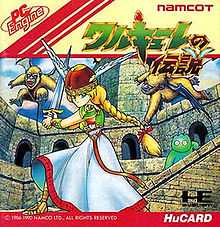Valkyrie no Densetsu
| Valkyrie no Densetsu | |
|---|---|
 Arcade flyer of Valkyrie no Densetsu. | |
| Developer(s) | Namco |
| Publisher(s) | Namco |
| Platform(s) | Arcade, PC Engine, Virtual Console |
| Release date(s) |
PC Engine
|
| Genre(s) | Action |
| Mode(s) | 2 players can play simultaneously |
| Cabinet | Upright, cabaret, and cocktail |
| Arcade system | Namco System 2 |
| Display | Vertical orientation, Raster, 224 x 288 |
Valkyrie no Densetsu (ワルキューレの伝説 Warukyūre no Densetsu, lit. "The Legend of Valkyrie") was released by Namco in 1989 in Arcades and in 1990 on the PC Engine only in Japan. It is a sequel to a Japan-only 1986 Nintendo Family Computer game entitled Valkyrie no Bōken: Toki no Kagi Densetsu. For the first time, Valkyrie no Densetsu was translated into English and released in the Namco Museum Volume 5 compilation for the PlayStation. The PC Engine version later was ported to the Wii's Virtual Console only in Japan. The arcade version was released on the Virtual Console on December 8, 2009 in Japan.
Gameplay
Player one controls Valkyrie while player two controls Krino Sandra (official Namco Museum romanization; he has also been romanized as Xandra, and was also named Whirlo in the English version of Xandra no Daibōken: Valkyrie to no Deai), a green lizard who, despite the name, is actually male (and his resemblance to a lizard isn't obvious). They fight enemies with their sword (Valkyrie) and trident (Sandra). The players can also hold down the attack button to use magic.
Differences between versions

The PC Engine version of the game sports a big number of differences that almost make it a new game. The level design has been changed in the later levels, new stages have been added, you are given passwords to save your progress, there is an extra boss battle right before you fight the last boss, and the ending is completely different from the arcade version.
External links
- Valkyrie no Densetsu guide at StrategyWiki
- Valkyrie no Densetsu at MobyGames
- Valkyrie no Densetsu at arcade-history
- DeviFoxx's Valkyrie series history and resource website
| |||||